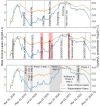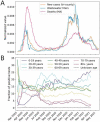This is a preprint.
Metrics to relate COVID-19 wastewater data to clinical testing dynamics
- PMID: 34159339
- PMCID: PMC8219106
- DOI: 10.1101/2021.06.10.21258580
Metrics to relate COVID-19 wastewater data to clinical testing dynamics
Update in
-
Metrics to relate COVID-19 wastewater data to clinical testing dynamics.Water Res. 2022 Apr 1;212:118070. doi: 10.1016/j.watres.2022.118070. Epub 2022 Jan 14. Water Res. 2022. PMID: 35101695 Free PMC article.
Abstract
Wastewater surveillance has emerged as a useful tool in the public health response to the COVID-19 pandemic. While wastewater surveillance has been applied at various scales to monitor population-level COVID-19 dynamics, there is a need for quantitative metrics to interpret wastewater data in the context of public health trends. We collected 24-hour composite wastewater samples from March 2020 through May 2021 from a Massachusetts wastewater treatment plant and measured SARS-CoV-2 RNA concentrations using RT-qPCR. We show that the relationship between wastewater viral titers and COVID-19 clinical cases and deaths varies over time. We demonstrate the utility of three new metrics to monitor changes in COVID-19 epidemiology: (1) the ratio between wastewater viral titers and clinical cases (WC ratio), (2) the time lag between wastewater and clinical reporting, and (3) a transfer function between the wastewater and clinical case curves. We find that the WC ratio increases after key events, providing insight into the balance between disease spread and public health response. We also find that wastewater data preceded clinically reported cases in the first wave of the pandemic but did not serve as a leading indicator in the second wave, likely due to increased testing capacity. These three metrics could complement a framework for integrating wastewater surveillance into the public health response to the COVID-19 pandemic and future pandemics.
Conflict of interest statement
Declaration of Competing Interests
MM and NG are cofounders of Biobot Analytics. EJA is advisor to Biobot Analytics. CD, NE, MI, and KAM are employees at Biobot Analytics, and all these authors hold shares in the company.
Figures





References
-
- Baker C.D., 2021a. Order advancing all communities to Phase III, Step 2 of the Commonwealth’s reopening plan. Commonwealth of Massachusetts Office of the Governor.
-
- Baker C.D., 2021b. Order advancing all communities to Phase IV, Step 1 of the Commonwealth’s reopening plan and transitioning to a travel advisory policy. Commonwealth of Massachusetts Office of the Governor.
-
- Baker C.D., 2020a. Order implementing a phased reopening of workplaces and imposing workplace safety measures to address COVID-19. Commonwealth of Massachusetts Office of the Governor.
-
- Baker C.D., 2020b. Order authorizing the re-opening of Phase II enterprises. Commonwealth of Massachusetts Office of the Governor.
-
- Baker C.D., 2020c. Order further advancing the re-opening of Phase II enterprises. Commonwealth of Massachusetts Office of the Governor.
Publication types
Grants and funding
LinkOut - more resources
Full Text Sources
Miscellaneous
